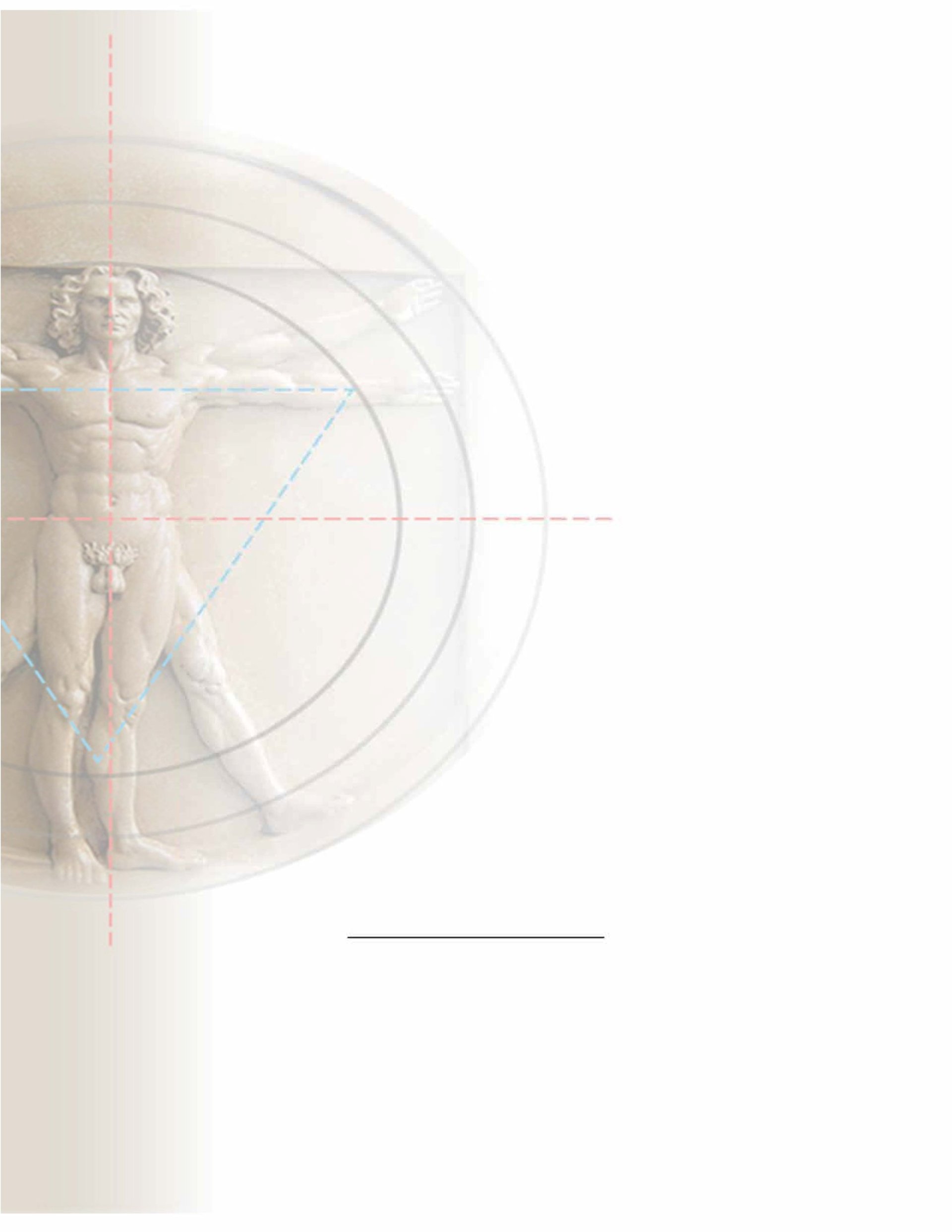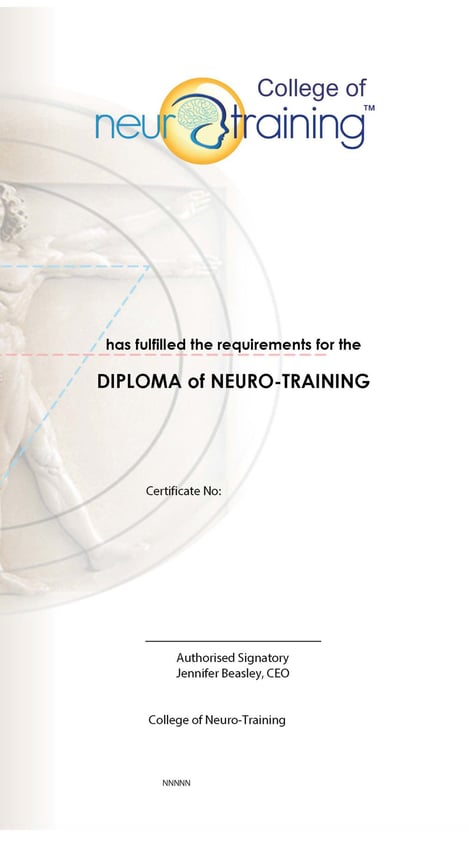
Diploma
College of Neuro-Training Diploma
CERTIFICATE AND DIPLOMA

The Neuro-Training Diploma
Diploma is equivalent to the Australian Neuro-Training Diploma: Extension of your Neuro-Training knowledge.
Here the subject matter is expanded. After completion of the diploma you will be able to support your clients comprehensively. You create further prerequisites for a successful work as a Neuro-Trainer.
Courses (total 320 hours)
Self-study (250 hours)
Assessments according to NT guidelines.


Course content:
Module D1: Functional Neuro-Training
In this course we will learn the neurological architecture of the various systems that help us adapt and function. They are simply remarkable. With each new discovery comes tremendous scope to help those around us experience life in new ways, and be able to recognize and appreciate those experiences with more fulfillment. In Neuro-Training, our understanding of the influence of neurological functions becomes clearer with each client.
Module D2: Yin Yang
Yin and Yang are familiar Chinese terms to Western ears. The concepts these terms embody are central to Taoist philosophy as well as Chinese medicine. The theory of Yin and Yang permeates every aspect of Chinese life and thought. The balance between these two primordial cosmic forces is considered a key factor in all natural phenomena and life processes. The interaction between Yin and Yang ignites all change and movement in the universe. Yin represents the negative, passive force. It is feminine in nature, dark, deep-seated, contracting, descending, and is symbolized by water.
Module D3: Neuro-Frequencies
For 200 years, the principles and uses of homeopathy have been researched and applied to patients. The German physician Samuel Christian Friedrich Hahnemann was the founder of homeopathic substances. Hahnemann turned away from conventional medicine, and began to study the underlying fundamental law of homeopathy - the principle of similarity, which is "similar things are cured by similar things."
The principle of similarity states that a remedy can cure a disease if it can produce symptoms similar or the same as those of the disease in a healthy person.
Module D4: Fears, Habits, Beliefs
"Fears, Habits and Beliefs" represents a natural extension of the principles established in the "Principles of Recovery" workshop. The Model Universal Principles of this workshop gave us a pattern that includes the various branches of neuro-training, as well as any other method of recovery that can be applied to a person's energy imbalances. The three main components of the Universal Principles model are the mental aspects of human existence, the emotional behaviors that give color and value to that existence, and the physical actions through which they are expressed.
Module D5: Emotional Defenses
The Universal Barometer (UB) is based on the extended development of emotional references for use in Neuro-Training (NT).
Since the mid 1980's there has been an increasing realization of the utility of the use of emotional responses in kinesiology. There have been many attempts to identify the effects emotions have on changing muscle responses until some consistent patterns emerged. John Barton from Biokinesiology developed the emotional responses for a whole range of tissue functions in the body, including meridian functions. Three in One Concepts developed a reference called the "behavioral barometer", it is used in their workshops. Neuro-Training has the Motivational Barometer, created by Andrew Verity. This section refers to the influence that suppression has on the value system, which creates either boredom if the suppression is maintained, or motivation if the suppression can be removed. It is based on the original psychological studies of how boredom develops in business. Andrew integrated it into an applicable reference for its use in neuro-training.
Module D6: Nutritional Alternatives
Integrating nutrition into neuro-training adds a new side to individuals experiencing the best in life.
Food is attributed to be the "cure" for most of the imbalances. When someone has a problem in their fitness, they first think of going to a doctor, then they think of the medication they need, and only then do they think of changing their diet. To me it seems to be the reverse of what happens naturally.Yes, it is true that,if you eat food with little nutritional value, it is detrimental. However, I have seen people who should be dead after what they ingest, and yet they are full of energy and life.
Module D7: Context of Recovery
Working with the Context of Recovery. Recovery is a natural state. Our ability to recover is a value given to us and an important part of how we experience life. As part of our original genetic programming, recovery, is only a problem for us when there is something that stops our natural restorative processes. There are related contexts to recovery that we should be at least aware of to better understand the nature of what we are challenging when "recovery" needs a better option.
Module D8: Practical Applications
The Universal Principles model consists of four primary references:
In the center is a triangle that refers to personal references. The innermost circle shows the family references. The next of the concentric circles is the social references. The outermost circle represents the influence of the Universal Laws. All the areas on the concentric circles relate to an equivalent area in the personal references. All of these areas have a common set of values that connect them in different contexts. The Mental (Personal) to the Father (Family), Religion (Social) and finally to Geometry (Universal Laws).
Choose a course from D10-D13
Module D10: King of the Glands Course
Everything about the adrenal glands and the adrenal glands as a system. What they affect, their hormones and muscles. HHN axes dysfunction, how to overcome adrenal exhaustion and adrenal wheel reference chart.
Four little organs produce hormones that regulate everything from blood pressure and libido to our metabolism and stress responses. That's a big job! These organs are: The hypothalamus, the pituitary gland, and the adrenal glands. As with any other part of the body, the adrenal glands do not function independently. Rather, they are part of a complex system called the hypothalamic-pituitary-adrenal loop (HHN axis). The central nervous system and endocrine system connect through this HHN axis and work together to regulate stress responses and hormone balance..
Module D11: Pain Elimination
Exploring the contexts most often displayed by clients, this model has brought much new insight into the nature of the principles of recovery and how we are structured to function. This workshop will address the relationship of the Chinese theory of energy and specifically how the theory incorporates one of the 9 pillars-pain. The Chinese description of Shen (ability to transform) is directly influenced by the habitual nature of pain responses. The more we defend against pain, the less we recover. We also know that recovery comes from an appropriate balance between the mental, emotional and physical contexts.
Poor recovery can come from an unresolved or suppressed imbalance in one or a combination of the three primary elements, which is also reflected in the meridian system.
Module D12: Universal Principles Model
The diagram, what we use is a description of what has become known as the Model of Universal Principles. This has proven to be one of the most important influences in the development of how to view neuro-training and apply it effectively.
With ongoing research, the meaning of the universal principles model began to unfold in its symbolic references as a contextual model. It showed that in order to be able to include all the necessary references in working with a client, we needed to know what context we were working in. This led to the realization that if the right values were united with the corrections made, we would achieve greater and longer lasting effects.
The right values were able to be brought to the surface simply by identifying the context in which the problem had been created in the first place. Any corrections made in this context meant that the corrections would be associated with the correct set of values and the person could heal more easily.
Module 13 Time Cycles
